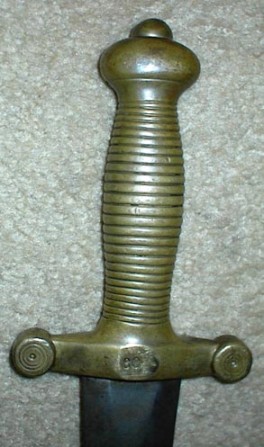FOOT ARTILLERY SWORD
aka French Model 1831
Dismounted Artillery Sword

This is a Foot-Artillery Short-Sword from the period of 1831 to about 1870.
Manufactured at various French arsenals - namely Thiebaut (or Talibot) [a foundry in France], St. Etienne, and Chatellerault - and are so marked - along with month and year; various inspector's stamps.
Neo-classical in design, based upon the Roman Gladius. Nicknamed coupe-choux, which roughly translates to "cabbage-cutter."
Overall length is ~25-1/8".
Hilt is ~6" in length and is constructed entirely of brass; cross-guard is ~4-1/8" in width; grip is patterned with 26 raised ribs or rings. I have owned one of these with an anchor
stamped in the center of the cross-guard; this usually indicates colonial or naval usage and is not a common marking (see image below).
Double-edged, diamond-cross-section blade is ~19-1/8" in length.
The American "Model 1832" Foot Artillery Sword and the British "Land Transport Corps Privates's Hanger "Pattern 1855", and the Russian "Pattern 1848" are very similar.
It has been suggested that the French Model 1831 was used by the Confederacy during the American Civil War; without provenance, however,
the rule of thumb is that, "for it to be Confederate, it must say "CS" or "CSA," be from one of the known "Southern" manufacturers, or be
typical of what was produced in the South - based upon confirmed known examples - just prior to and during the Civil War."
There are quite a lot of French M1831 Foot Artillery Swords around, so inspect these very closely for alterations and attempts to make them
"Union" or "Confederate". The French were very good about profusely marking their weapons. Look for grinding marks in an attempt to remove these. On French swords, the ricasso is generally stamped with the mark of the Director, the Controller and the Reviser of the arsenal; this is especially true with swords manufactured at the Klingenthal arsenal in France. On trooper swords these marks are found on the guard as well.
The British swords are also profusely marked although they can occasionally be found with no markings at all.

